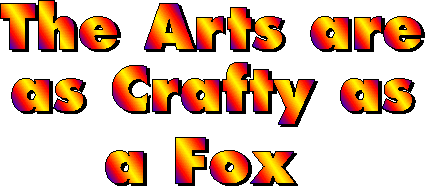

"You can always do something artsy craftsy" or he/she is pretty crafty, you know" -- these are red flag words, sure to raise the ire of those dedicated to the concepts of visual arts. After all, a fox may be crafty, but an artist or a fine craftsperson is just that. It is time we recognized that the arts are a business, a profession and mainstream programming of any community.
The cultural labour force has grown at a rate of 122% over the last 10 measured years, twice the rate of the Canadian labour market as a whole. This sector also represents almost 3% of the Gross Domestic Product of Canada (Canadian Conference of the Arts, 1993). As Marshall McLuhan has been quoted as saying, "We have moved from an era when business was our culture to one in which culture is our business". After all, the arts and cultural industry is the ninth largest industry in the country, with direct revenue of 11.5 billion.
In 1984, C.P.R.A. (Canadian Parks & Recreation Association) adopted a series of policy statements (15) and statements of principle on the role of recreation authorities in arts development and support. Their policies are based on a premise that "the arts contribute directly to the quality of life and economics of municipalities, and consequently have a significant bearing on parks and leisure services".
In addition, trends and various futurists, from John Naisbitt to Faith Popcorn, indicate that interest and participation in various art forms will accelerate in the next 10-20 years. Statistics are currently bearing this out.
Based on the above, I am assuming that it is no longer a question of whether to include arts and applied arts programming in your community, but rather a question of how best to do it. I am assuming that as programming professionals in the field, we recognize the need for and benefits of arts programming; The recognition that arts can:
- strengthen communities
- serve as therapy
- provide primary or secondary career choices
- develop communication
- develop self discovery and improved self-concept
- develop individual responsibility, creative problem solving, visual acuity, concentration, decision making and organization skills
- provide an avenue for social interaction and societal recognition
And, I am assuming that we all want to deliver excellence in our programs.
In arts and applied arts programming this means several things: Firstly, it means assessing the needs of the students and the resources available, ie:
1) qualified teachers; not just anyone can teach drawing or painting or stained glass. The skill development must also be accompanied by recognition of art principles such as colour, design and form. Conscious choice making of the student should be stressed or else they learn very little by rote application or "colour by numbers"
2) a space that is suitable - adequate lighting, work surfaces, access to sinks, plug-ins, etc.
3) appropriate materials, that may need to be of high quality (have you tried painting with a brush which leaves hair or paints which have very little pigment?).
4) recognition of learning needs (children, teens, adults) and the need for progressive development.
And perhaps most importantly, we need to provide the opportunity to be creative, to be inspired, to be encouraged and to be recognized.
We all need our entry level and comfort zone, and for some it may be macrame owls or plastic bag wreaths. But as any beginner can attest, with training and encouragement, the skill level and appreciation of aesthetic value increases. A skilled hockey player or chef or any craftsperson has received training and mentoring and has experienced failures and successes along the way.
The level to which community arts programming should be available is debatable. In the City of Red Deer, our mandate is basic levels of programming. This may in itself take various forms, for many can partake of community programming for years and still consider themselves as being at an entry level. Others, seem ready to try the professional route after one or two years of study. What is important is that there are opportunities for various levels of development from the 'scared stiff beginner' to the semi-professional to professional, and the role or recreation and culture departments, can vary, depending on other opportunities available in the community.
The recent Canadian Arts Consumer Profile reports that 91% of Canadians surveyed agree that "it is important to expose children to the arts". The Japanese make the following comment with regards to art education: "A grounding in the arts will help our children to see to bring a uniquely human perspective to science and technology." Long gone are the days of seeing arts as a sideshow but as part of the main course of program opportunities.
To paraphrase and extrapolate from an Aunt Mame quote, "life is a banquet and most people are starving". I'd like to venture that "life is a canvas, and most have not even picked up a crayon".
Lesia Davis is the Culture Programs Superintendent for the City of Red Deer Alberta, Recreation & Culture Department